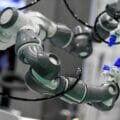Intelligence is based on observation. A brilliant mind must gather information before it can act upon it. Intelligent manufacturing is no different. Data is the foundation, and it must be collected. For best results, the data must be timely, relevant, and complete.
This kind of data collection depends on good data communications protocols. Today, IoT and Industrie 4.0 applications often use OPC UA and MQTT. OPC UA is most often used for in-plant connectivity, while MQTT provides networking connections.
Collecting data from industrial systems also require security. Best practices dictate that OT and IT networks be completely isolated from each other, using a DMZ and firewalls. A DMZ ensures no direct link between corporate networks and control networks. And firewalls protect both the OT and IT sides, configured to allow only outbound connections to the DMZ.
However, neither OPC UA nor MQTT were designed to work through a DMZ, which typically requires two or more servers, chained together one after the other. The OPC UA protocol is simply too complex to reproduce well in a daisy chain like this. MQTT requires each node in the chain to be individually configured, and its Quality of Service guarantees cannot propagate through the chain, making data unreliable.
Instead, to enable a secure, robust connection across a DMZ, and support real-time bidirectional communication, Skkynet recommends secure tunnelling. Well-designed tunnelling middleware can seamlessly aggregate a variety of industrial protocols like OPC, MQTT, and Modbus and send their data securely across a DMZ to clients running in IT or the cloud. There is no need for VPNs, and all inbound firewall ports can stay closed.
This secure-by-design tunnelling solution connects and integrates OPC UA and MQTT protocols at either or both ends of the tunnel and supports bi-directional data transfer across a DMZ in real time. It’s a way to gain the value of remote data access, with minimal risk.







